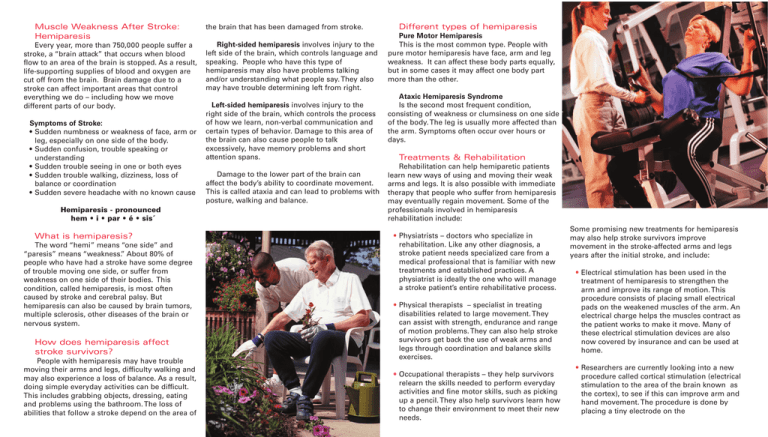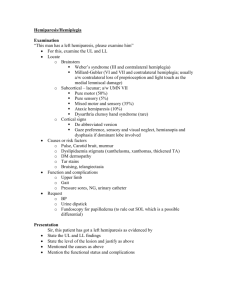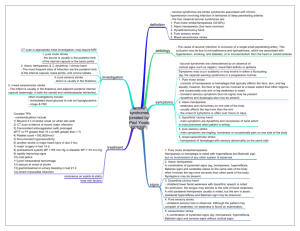Muscle Weakness After Stroke: Hemiparesis What is hemiparesis
advertisement

Muscle Weakness After Stroke: Hemiparesis Every year, more than 750,000 people suffer a stroke, a “brain attack” that occurs when blood flow to an area of the brain is stopped. As a result, life-supporting supplies of blood and oxygen are cut off from the brain. Brain damage due to a stroke can affect important areas that control everything we do – including how we move different parts of our body. Symptoms of Stroke: • Sudden numbness or weakness of face, arm or leg, especially on one side of the body. • Sudden confusion, trouble speaking or understanding • Sudden trouble seeing in one or both eyes • Sudden trouble walking, dizziness, loss of balance or coordination • Sudden severe headache with no known cause Hemiparesis - pronounced hem • i • par • é • sis´ What is hemiparesis? The word “hemi” means “one side” and “paresis” means “weakness.” About 80% of people who have had a stroke have some degree of trouble moving one side, or suffer from weakness on one side of their bodies. This condition, called hemiparesis, is most often caused by stroke and cerebral palsy. But hemiparesis can also be caused by brain tumors, multiple sclerosis, other diseases of the brain or nervous system. How does hemiparesis affect stroke survivors? People with hemiparesis may have trouble moving their arms and legs, difficulty walking and may also experience a loss of balance. As a result, doing simple everyday activities can be difficult. This includes grabbing objects, dressing, eating and problems using the bathroom. The loss of abilities that follow a stroke depend on the area of the brain that has been damaged from stroke. Right-sided hemiparesis involves injury to the left side of the brain, which controls language and speaking. People who have this type of hemiparesis may also have problems talking and/or understanding what people say. They also may have trouble determining left from right. Left-sided hemiparesis involves injury to the right side of the brain, which controls the process of how we learn, non-verbal communication and certain types of behavior. Damage to this area of the brain can also cause people to talk excessively, have memory problems and short attention spans. Damage to the lower part of the brain can affect the body’s ability to coordinate movement. This is called ataxia and can lead to problems with posture, walking and balance. Different types of hemiparesis Pure Motor Hemiparesis This is the most common type. People with pure motor hemiparesis have face, arm and leg weakness. It can affect these body parts equally, but in some cases it may affect one body part more than the other. Ataxic Hemiparesis Syndrome Is the second most frequent condition, consisting of weakness or clumsiness on one side of the body. The leg is usually more affected than the arm. Symptoms often occur over hours or days. Treatments & Rehabilitation Rehabilitation can help hemiparetic patients learn new ways of using and moving their weak arms and legs. It is also possible with immediate therapy that people who suffer from hemiparesis may eventually regain movement. Some of the professionals involved in hemiparesis rehabilitation include: • Physiatrists – doctors who specialize in rehabilitation. Like any other diagnosis, a stroke patient needs specialized care from a medical professional that is familiar with new treatments and established practices. A physiatrist is ideally the one who will manage a stroke patient’s entire rehabilitative process. • Physical therapists – specialist in treating disabilities related to large movement. They can assist with strength, endurance and range of motion problems. They can also help stroke survivors get back the use of weak arms and legs through coordination and balance skills exercises. • Occupational therapists – they help survivors relearn the skills needed to perform everyday activities and fine motor skills, such as picking up a pencil. They also help survivors learn how to change their environment to meet their new needs. Some promising new treatments for hemiparesis may also help stroke survivors improve movement in the stroke-affected arms and legs years after the initial stroke, and include: • Electrical stimulation has been used in the treatment of hemiparesis to strengthen the arm and improve its range of motion. This procedure consists of placing small electrical pads on the weakened muscles of the arm. An electrical charge helps the muscles contract as the patient works to make it move. Many of these electrical stimulation devices are also now covered by insurance and can be used at home. • Researchers are currently looking into a new procedure called cortical stimulation (electrical stimulation to the area of the brain known as the cortex), to see if this can improve arm and hand movement. The procedure is done by placing a tiny electrode on the muscles can be activated as if the person is actually doing the activity. Mental practice, sometimes called Motor Imagery (MI) helps people imagine or visualize their limbs moving. This practice may improve arm movement in people with hemiparesis. It has also been suggested that MI may be useful in helping people walk. • Modified constraint-induced therapy (mCIT) is a treatment where stroke patients with hemiparetic arms visit a therapist three times a week for a half hour during a 10-week period. During that time, as well as at home for several hours per day, they practice focused exercises using the weak arm. Research studies show that modified CIT increases use and movement in the affected arm. However, this type of therapy only works on patients who have some movement in their wrists and fingers. Where can I go for additional information? tough membrane covering the brain (the dura). The electrode sends an electrical current to the brain while a patient undergoes rehabilitation exercises. Currently, this type of therapy is only targeted toward patients who have some movement in their wrists and fingers. • Many studies also show that certain treatments can be helpful in relaxing the muscles in people who have “tone” or what is sometimes called “spasticity.” In this condition, a certain body part on the affected side is hard to move and the muscles feel as if they are tightened up. Treatments such as the injection of botulinum toxin (Botox) and the use of baclofen can improve this condition. • When people imagine themselves using a certain body part, areas of the brain and National Stroke Association 1-800-Strokes (800-787-6537) www.stroke.org National Institutes of Health (301) 496-4000 www.nih.gov To locate an accredited rehabilitation facility (888) 281-6531 www.carf.org Research Clinical trial listings by disease or condition www.clinicaltrials.gov www.centerwatch.com www.rehablab.org Sponsored by Northstar Neuroscience (888) 546-9779 www.northstarneuro.com 1-800-STROKES (1-800-787-6537) www.stroke.org NSA publications are reviewed for scientific and medical accuracy by the NSA Publications Committee. © National Stroke Association 2006 BG9




